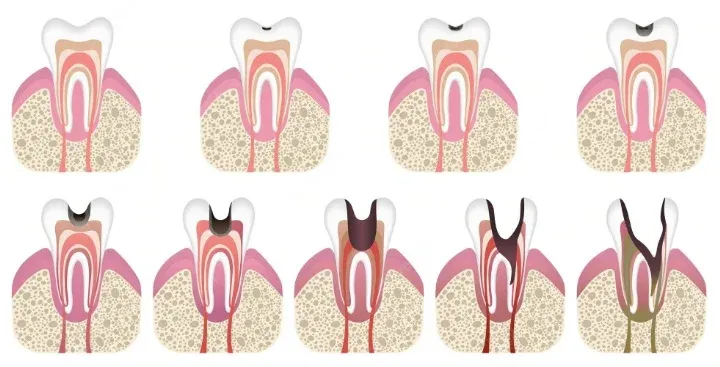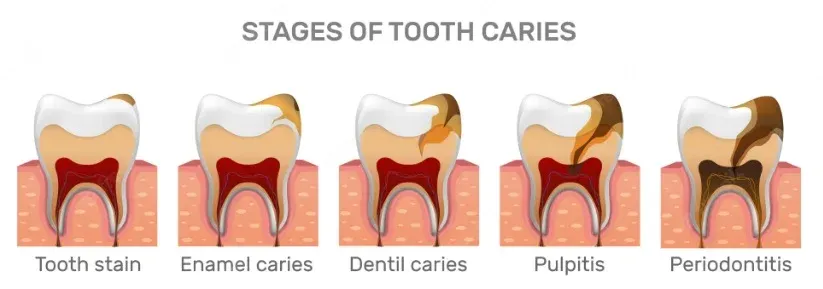5 Dangers of Pulling an Abscessed Tooth: Tooth Abscess Stages with Pictures
When it comes to oral health, an abscessed tooth is a serious matter that requires prompt…
When it comes to oral health, an abscessed tooth is a serious matter that requires prompt attention. The condition is characterized by a pocket of pus resulting from an infection that has spread to the center of the tooth. Extracting an abscessed tooth, also known as tooth extraction, may be the best course of action in some cases.
dangers of pulling an abscessed tooth includs potential complications such as spread of infection, damage to surrounding teeth, dry socket, bone loss and nerve damage. It’s essential to consult with a dental professional to determine the best course of treatment for an abscessed tooth to prevent the spread of infection and potential complications.
Dangers of pulling an abscessed tooth:
An abscessed tooth is a serious oral health condition that occurs when an infection spreads to the center of the tooth, leading to a pocket of pus. If left untreated, an abscessed tooth can cause severe pain, swelling, and other complications. Extracting an abscessed tooth, also known as tooth extraction, can be a necessary treatment option in some instances. the dangers includes:
- Contagion: If an abscessed tooth is not drained prior to extraction, the infection may spread to surrounding tissue, causing more severe issues such as sepsis.
- Adjacent tooth injury: There is a possibility of damaging adjacent teeth or roots during the extraction process.
- Dry socket: If the blood clot that forms in the socket post-extraction is dislodged or dissolved, dry socket can occur, leading to severe pain and a delay in healing.
- Bone deterioration: If the infection has spread to the bone, there may be a loss of bone in the area, which can affect the stability of any future dental procedures.
- Nerve damage: In rare cases, the nerve that runs through the jawbone can be damaged during the extraction, resulting in numbness or tingling in the lower lip, tongue, or chin.
What happens to the abscessed after a tooth extraction:
In the following , we’ll explore What happens to the abscessed after a tooth extraction:
When a tooth is extracted, the abscess that caused the infection will also begin to heal. The healing process starts with the formation of a blood clot in the socket, which helps to stop bleeding and initiates the healing process. In the days following the extraction, the area may be swollen and sore, and there may be some mild bleeding or oozing.
As the healing process proceeds, the body’s immune system will start to fight off the infection caused by the abscess. White blood cells will travel to the area, breaking down and removing the bacteria and pus that had accumulated in the abscess.
The body will then start rebuilding the area by forming new tissue, called granulation tissue, which will fill in the socket left by the extracted tooth. This tissue is pink and slightly raised, and it will eventually turn white as it matures.
After about three weeks, the socket should have healed mostly, and the granulation tissue will have transformed into a more firm, white tissue. It’s important to keep in mind that every person’s healing process is unique and healing times may vary.
To ensure proper healing, it’s important to maintain good oral hygiene by brushing and flossing gently around the extraction site and avoiding hard or crunchy foods. Additionally, taking any prescribed antibiotics and keeping the area clean are important steps to ensure proper healing. If you have any concerns
Tooth abscess stages pictures:
Tooth abscess is a serious oral health condition that progresses through different stages, each with its unique characteristics and symptoms. Here is a general overview of the stages of a tooth abscess:
- Incipient stage: At this stage, bacteria from various sources infiltrate the tooth, infecting the pulp. This can result in pain, sensitivity, and local swelling.
- Progressive stage: As the infection spreads, the abscess begins to form. Pus and bacteria congregate in the pulp chamber and may start to traverse the root canals. This can cause more intense pain and swelling.
- Advanced stage: In this stage, the abscess continues to grow and can cause fever, difficulty opening the mouth, and swollen lymph nodes. The tooth may appear discolored, and the gums may be red, swollen, and tender to the touch.
- Complicated stage: If left untreated, the abscess can lead to severe complications such as cellulitis, spreading the infection to other parts of the body, or sepsis.
It’s worth noting that every person’s experience with a tooth abscess can be different and the severity of the symptoms may vary. Here are Tooth abscess stages pictures:
Images:

Pulling an abscessed tooth without antibiotics:
Pulling an abscessed tooth, also known as tooth extraction, can be a necessary treatment option for an abscessed tooth. However, it’s crucial to understand that antibiotics are typically a crucial part of the treatment process before and after the extraction. This is because an abscessed tooth is the result of an infection, and antibiotics are necessary to help fight off the infection and prevent it from spreading. so pulling an abscessed tooth without antibiotics can be dangerous .
If an abscessed tooth is not treated with antibiotics before the extraction, there is a higher risk of the infection spreading to the surrounding tissue. This can lead to more serious complications such as cellulitis, a spreading infection to other parts of the body, or sepsis. Moreover, if antibiotics are not prescribed after the extraction, there is a chance that the infection will not be completely treated and the abscess may reoccur.
It’s important to remember that tooth extraction is not a replacement for antibiotics; instead, it should be considered as part of the overall treatment plan. Antibiotics play a vital role in fighting the infection and preventing potential complications. Before considering tooth extraction, it’s always best to consult with a dental professional and follow their recommendation for the best course of treatment. This can help to ensure that the infection is fully treated and prevent future complications.







